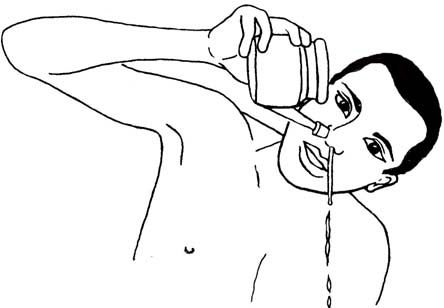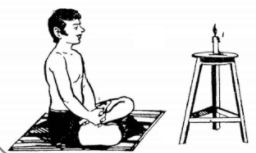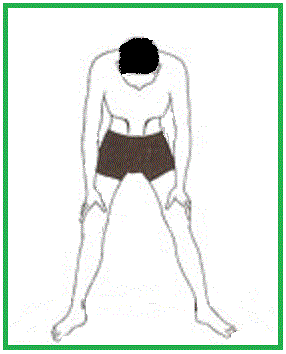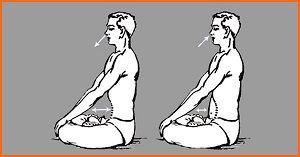 |
Information published here is for reference purpose only. We recommend proper guidence should be taken from the trained authority for yogic practices. The purpose of compiling/listing/detailing these information here is for publishers and our practictioners quick references. Visitor of this page can use these information for reading purpose only.. |
General informations: We have collected these information from various internet sources for our practice references only.
Other reference Reading: YogaHome | YogAsana | YogaGyan | YogaMudra | YogaMore | YogaSutra | YogaFor
The Shatkarmas (Sanskrit: षटकर्म ṣaṭkarma literally six actions), also known as Shatkriyas, are a set of Hatha yoga purifications of the body, to prepare for the main work of yoga towards moksha (liberation). Practicing shatkarmas internally purifies the body, which makes pranayama and meditation practice easier by preparing the body to perform these practices without distraction, discomfort or fatigue.
The shatkarmas should always be learned from and practiced under the supervision of an experienced teacher.
Neti, Dhouti, Basti, Tratak, Nauli, Kapalbhati
      |
Dhauti: Dhauti
karma is the first procedure described in ShatKarma. ‘Dhauti’ is a
Sanskrit word which means- ‘Washing or cleaning’. In Gherand a Samhita
four types of Dhauti have been described, which are: AntarDhauti,
DantaDhauti, HridDhauti, and Moolshodhan. Other widly explained dhauti
kriya's are Waman dhauti, Warisar dhauti. In Waman dhauti one can drink
warm water mixed with little salt and vomit out with help of hand
fingers pressing root of toung until all water comes out of tummy.
Warisaar also called as Shankhprakshalan which is a long process
explained below. There are other dhauti practices like Jivaa dhauti,
Kapal Randhra dhauti, Karna randhra dhauti, Chakshu Dhauti one can
practice time to time to keep our sensory organs clean.
Basti: Enema (cleansing of intestines through anal route).
Neti: Two types of neti kriya - Jala Neti, Sutra Neti. Other types are Dugdha, Ghrta, Tel, Swamutra Neti
Jala Neti is done with lukewarm water while Sutra Neti is done using cotton thread inserted from Nose to Mouth.
Tratak: Looking intently with blinkless gaze at a small point until tears are shed is known as Tratak Kriya.Tratak is practised to activate unknown powers of the mind. Tratak is extremely powerful sadhna.
Nauli: It is the yogic exercise where the turning of the abdominal muscles take place
Kapalbhati: As per Gherand Samhita following text regarding Kapalbhati:
Basti: Enema (cleansing of intestines through anal route).
Neti: Two types of neti kriya - Jala Neti, Sutra Neti. Other types are Dugdha, Ghrta, Tel, Swamutra Neti
Jala Neti is done with lukewarm water while Sutra Neti is done using cotton thread inserted from Nose to Mouth.
Tratak: Looking intently with blinkless gaze at a small point until tears are shed is known as Tratak Kriya.Tratak is practised to activate unknown powers of the mind. Tratak is extremely powerful sadhna.
Nauli: It is the yogic exercise where the turning of the abdominal muscles take place
Kapalbhati: As per Gherand Samhita following text regarding Kapalbhati:
Vatkramen vyutkramen shitkramen visheshatah |
Bhalbhatim tridha kuryat kaphadosham niwaryet || G S 1.54
There
are three types of Kapalbhati - Vatkrama, Vyutkrama and Sheetkram. By
performing kapalbhati doshas of kapha are eliminated.
The next shloka describes Vatkram Kapalbhati.
1: Vatkrama Kapalbhati (air cleansing) This practice is the same as Kapalbhati Pranayama,
2: Vyutkrama Kapalbhati (sinus cleansing) Fill a bowl with pure warm water and add salt to the ratio of one teaspoon per half litre, ensuring the salt is well dissolved. Stand comfortably and bend over the bowl of water. Relax the whole body as much as possible in this position. Scoop the water up in the palm of the hand and sniff it in through the nostrils. Let the water flow down to the mouth and then expel it. Practice in this way several times. Dry the nostrils properly as described for jala neti. This completes the practice.
3: Sheetkrama Kapalbhati (mucous cleansing) Prepare the water as above. Stand comfortably and bend over the bowl of water. Take a mouthful of the warm saline water. Instead of swallowing it, however, push it up and expel it through the nose. Practise in this way several times. Dry the nostrils as described for jala neti. This completes the practice. Time of practice: The best time is early in the morning. However, vyutkrama and sheetkra1na kapalbhati may be performed at any time of the day except after meals. Duration: Vyutkrama and sheetkrama kapalbhati should take only a few minutes each and may be performed as a weekly routine.
The next shloka describes Vatkram Kapalbhati.
1: Vatkrama Kapalbhati (air cleansing) This practice is the same as Kapalbhati Pranayama,
2: Vyutkrama Kapalbhati (sinus cleansing) Fill a bowl with pure warm water and add salt to the ratio of one teaspoon per half litre, ensuring the salt is well dissolved. Stand comfortably and bend over the bowl of water. Relax the whole body as much as possible in this position. Scoop the water up in the palm of the hand and sniff it in through the nostrils. Let the water flow down to the mouth and then expel it. Practice in this way several times. Dry the nostrils properly as described for jala neti. This completes the practice.
3: Sheetkrama Kapalbhati (mucous cleansing) Prepare the water as above. Stand comfortably and bend over the bowl of water. Take a mouthful of the warm saline water. Instead of swallowing it, however, push it up and expel it through the nose. Practise in this way several times. Dry the nostrils as described for jala neti. This completes the practice. Time of practice: The best time is early in the morning. However, vyutkrama and sheetkra1na kapalbhati may be performed at any time of the day except after meals. Duration: Vyutkrama and sheetkrama kapalbhati should take only a few minutes each and may be performed as a weekly routine.
Other Kriya's (cleansing process) - Waarissar
Shankha Prakshalan : Day before this kriya eat lighter food or fruit diet. The next day in the morning cleanup and follow this process. To start with make 15-20 glasses of warm water with 5-6 tea spoon of salt. Seat in Malasan (squat) and drink 2 glasses of that water followed by 5 asanas (Tadasan, Tiryak Tadasan, Kati Chakrasahn, UdarKarsanasan, Tiryak Bhujangasan) repeat for 7 times. Cleanup after 4th or 5th round. Rest for an 45 minutes in shavasan. Have Khichadi made with Rice/mungdaal/ghee. Avoid any physcial activity that day. Follow lighter activity next day.
Shankha Prakshalan : Day before this kriya eat lighter food or fruit diet. The next day in the morning cleanup and follow this process. To start with make 15-20 glasses of warm water with 5-6 tea spoon of salt. Seat in Malasan (squat) and drink 2 glasses of that water followed by 5 asanas (Tadasan, Tiryak Tadasan, Kati Chakrasahn, UdarKarsanasan, Tiryak Bhujangasan) repeat for 7 times. Cleanup after 4th or 5th round. Rest for an 45 minutes in shavasan. Have Khichadi made with Rice/mungdaal/ghee. Avoid any physcial activity that day. Follow lighter activity next day.
Yoga is nothing
else but a science of awareness.